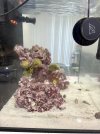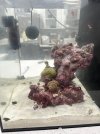Thank you for the comment. I'm referring to https://www.hikariusa.com/frozen_folder/mysis_shrimp.html cubes. In one feeding i feed 1/2 a cube (3.5 oz) of either Mysis or Brine or 8 pellets (4 for each fish) (Small Pellets - 1.2mm).
I'll probably decrease my feeding as per your suggestion. What do you recommend to get my Nutrients up (NO3).
Joined as a supporting member. I honestly did not how to something like it existed. Thank you for info
First of thank you for becoming a supporting member, as i've seen it said by several others you support the club, and the club supports you.
I would say from your additional details that you are most likey ok with what you are feeding per feeding. Originally I wasn't sure if you were feeding them all of those in a single feeding twice a day like a mini buffet. I would say continue as you have but maybe try only one feeding a day for a few days and than just observe the tank conditions for better or worse effects and watch your fishes Behaviors . Than you sould adjust things slowly based on your observations.
As far as flow goes, I can't say from a picture if you have enough flow at very bottom of tank. Ideally you want enough flow on the bottom that it doesn't allow detritus to build up and settle on the bottom. You want enough flow that detritus mostly stays suspended in the water so filtration removes it. At the same time you don’t want so much flow that its blowing sand around or pissing off coarl. So you want some movement on the bottom but not to much.
Signs of not enough flow or having a dead spot (area where flow doesn't reach on the bottom would be patches of dirt, left over food, or fish poop settling in a spot on the bottom. Such as a corner next to a rock. (fyi- dead spot solution small wave maker for that area or adjusting existing flow to elimnate/reduce those spots)
You no doubt will have heaps of various advice. This is in no way implying that you do all these at the same time such would be drastic and not helpful.
I would consider feeding what your doing once a day instead of twice and observing results.
Most of all try to connect with eric (the Gentlemen that offered to use a microscope for you - he knows his stuff) get him a sample of the stuff your dealing with.
Pause the flow while you get clean small container and collect a sample of it. Than it can be viewed under microscope to identify it's type so the proper Treatment for the specific type of dinoflagellates if that's what it is can be implemented. Anything else is guessing,hoping for the best, or wasting your time with trying things that maynbe ineffective. Looking through a microscope will give you actual answers as to what it is and how to resolve it.
I'm new compared to most here and still learning myself, so please don’t consider me to be a expert. Only passing on some generalizations I’ve been able absorb.
Definitely hope your able to come out to the swap, than you can see how fun we are in person.
Last edited:



